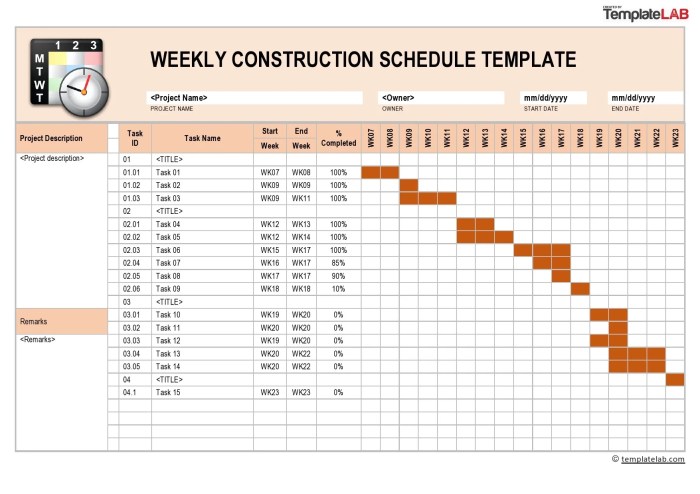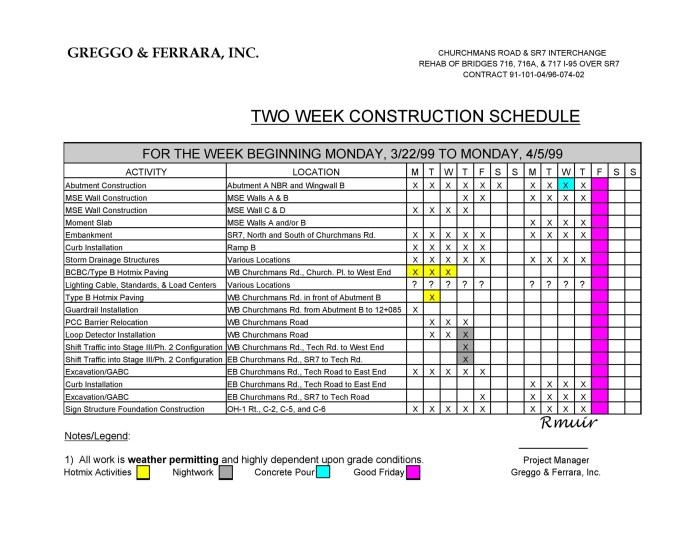Construction project scheduling and planning are crucial aspects that can make or break a project. From ensuring timelines are met to optimizing available resources, this topic delves into the core principles that drive successful construction projects.
Exploring the key elements of project planning, the significance of efficient scheduling, and the tools available, this discussion aims to provide a comprehensive overview of how to navigate the complexities of construction projects effectively.
Importance of Construction Project Scheduling
Effective project scheduling is crucial in the construction industry as it helps to streamline the workflow, optimize available resources, and ensure timely completion of projects. By creating a detailed schedule, construction companies can allocate resources efficiently, minimize delays, and enhance overall project management.
Impact of Poor Scheduling
Poor scheduling can have significant negative impacts on construction projects. For example, delays in one phase of the project can cause a ripple effect, leading to delays in subsequent phases. This can result in increased costs, missed deadlines, and client dissatisfaction. In addition, poor scheduling can lead to overallocation or underutilization of resources, causing inefficiencies and project bottlenecks.
Benefits of a Well-Structured Project Schedule
- Improved Time Management: A well-structured project schedule helps to prioritize tasks, set realistic deadlines, and ensure that the project stays on track.
- Resource Optimization: By clearly defining resource requirements and availability, a project schedule helps to allocate resources effectively and avoid shortages or overages.
- Risk Identification: Through detailed scheduling, potential risks and challenges can be identified early on, allowing for mitigation strategies to be implemented proactively.
- Enhanced Communication: A project schedule serves as a roadmap for all project stakeholders, facilitating clear communication and coordination among team members.
- Cost Control: Effective scheduling enables better cost forecasting and budget management, helping to prevent cost overruns and financial surprises.
Key Elements of Construction Project Planning
Construction project planning involves several key elements that are crucial for the successful completion of a project. These elements help in organizing tasks, resources, and timelines effectively to ensure that the project is completed on time and within budget.
Identify the essential components of a construction project plan
- Project Scope: Clearly define the objectives, deliverables, and constraints of the project.
- Work Breakdown Structure (WBS): Break down the project into smaller, manageable tasks.
- Resource Allocation: Assign resources such as personnel, equipment, and materials to each task.
- Risk Management Plan: Identify potential risks and develop strategies to mitigate them.
- Communication Plan: Establish a communication strategy to keep all stakeholders informed throughout the project.
Discuss how to create a detailed project timeline
Creating a detailed project timeline is essential to ensure that tasks are completed on time and in the correct sequence. This involves:
- Identifying all tasks and milestones in the project.
- Estimating the duration of each task based on historical data or expert judgment.
- Sequencing tasks in the right order to minimize dependencies and delays.
- Assigning start and end dates to each task to create a timeline.
- Regularly updating the timeline to track progress and make adjustments as needed.
Explain the role of resource allocation in project planning
Resource allocation is a critical aspect of project planning as it ensures that the right resources are available at the right time to complete tasks efficiently. This involves:
- Identifying the resources required for each task, including personnel, equipment, and materials.
- Assigning resources based on availability, skills, and cost.
- Monitoring resource usage to prevent overallocation or shortages.
- Adjusting resource allocation as needed to address any issues or changes in the project.
Tools and Software for Construction Scheduling

When it comes to construction project scheduling, utilizing the right tools and software can make a significant difference in the efficiency and success of the project. By leveraging technology, construction teams can streamline the scheduling process, improve communication, and enhance overall project management.
Comparison of Construction Scheduling Software
- Primavera P6: Known for its robust features and capabilities, Primavera P6 is a popular choice for large-scale construction projects. It offers advanced scheduling, resource management, and reporting tools.
- Microsoft Project: A versatile option suitable for smaller to mid-sized projects, Microsoft Project provides user-friendly interfaces and integration with other Microsoft Office tools.
- Procore: Designed specifically for the construction industry, Procore offers project management solutions, including scheduling, document management, and collaboration tools.
- Smartsheet: Ideal for teams looking for a cloud-based solution, Smartsheet enables easy collaboration, task tracking, and project scheduling in real-time.
Guide to Choosing the Right Scheduling Tool
- Assess project requirements: Consider the size, complexity, and specific needs of the project to determine which software aligns best with your goals.
- Scalability and compatibility: Choose a tool that can grow with your project and integrates well with other software used by your team.
- User-friendly interface: Opt for software that is intuitive and easy to use, ensuring team members can quickly adapt and collaborate effectively.
- Cost and budget: Evaluate the pricing structure of different tools to find one that fits within your budget while providing the necessary features.
Benefits of Using Technology in Project Scheduling
- Improved accuracy: Automated scheduling reduces human errors and ensures precise timelines and resource allocation.
- Enhanced collaboration: Cloud-based tools enable real-time updates and seamless communication among team members, subcontractors, and stakeholders.
- Efficient resource management: Software solutions help optimize resource utilization, preventing bottlenecks and delays in the construction process.
- Data-driven decision-making: Access to project data and analytics allows for informed decision-making, leading to better project outcomes.
Techniques for Efficient Project Scheduling: Construction Project Scheduling And Planning
Efficient project scheduling is crucial in ensuring successful completion of construction projects within deadlines and budget constraints. Utilizing the right techniques can help streamline the process and optimize resource allocation.
Critical Path Method (CPM) in Construction Scheduling
The Critical Path Method (CPM) is a widely used technique in construction project scheduling that identifies the sequence of tasks that are critical to the project’s timeline. By determining the longest path of dependent tasks, project managers can prioritize activities that directly impact the project’s completion date. CPM helps in identifying potential delays and allows for better resource management to ensure timely project delivery.
Advantages of Gantt Charts for Project Scheduling
Gantt charts are visual representations of project schedules that show tasks, durations, and dependencies in a timeline format. One of the main advantages of using Gantt charts is their ability to provide a clear overview of the project timeline, allowing for better coordination and communication among team members. They also help in identifying overlapping tasks and potential bottlenecks, enabling project managers to make necessary adjustments to meet project deadlines.
Tips for Optimizing Project Schedules, Construction project scheduling and planning
– Regularly update and monitor the project schedule to track progress and identify any deviations from the planned timeline.
– Prioritize tasks based on their criticality and dependencies to ensure that essential activities are completed on time.
– Allocate resources efficiently by considering task dependencies, resource availability, and skill requirements.
– Incorporate buffer time in the schedule to account for unexpected delays or changes in project scope.
– Utilize project management software to streamline scheduling processes and improve collaboration among team members.
Final Review

In conclusion, mastering the art of construction project scheduling and planning is the cornerstone of project success. By understanding the importance of efficient scheduling, leveraging the right tools, and implementing best practices, construction projects can be executed seamlessly, meeting deadlines and budget constraints effectively.
When it comes to programming, the first thing you learn is usually the famous phrase ” Hello world! “. It serves as a simple introduction to the world of coding, a way to display a basic output on the screen.
Embracing this iconic tradition can be the starting point for a journey into the exciting realm of software development.
When it comes to programming, the first thing you learn is usually the famous phrase ” Hello world! “. It serves as a simple introduction to the world of coding and software development. This basic program is often the starting point for beginners, helping them understand the fundamental concepts of programming.
Embracing this simple phrase can open up a whole new realm of possibilities in the tech industry.